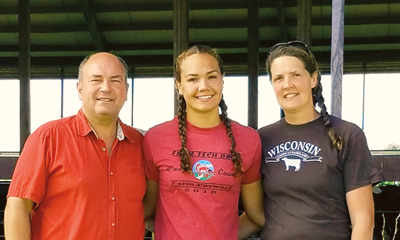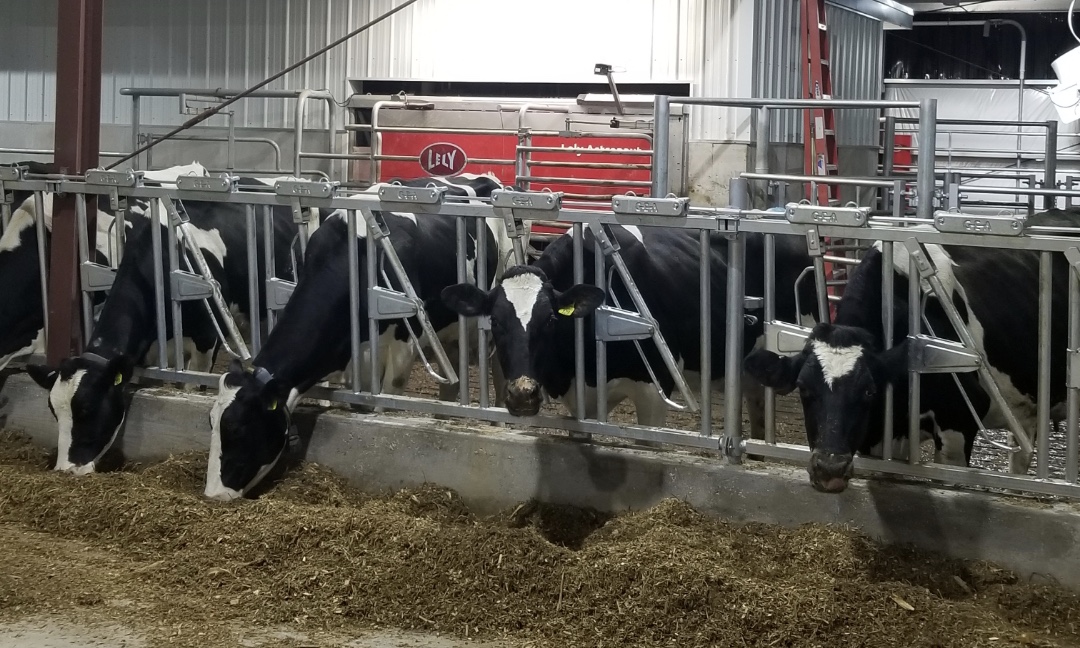Not much has changed yet at Hinchley’s Dairy Farm in Cambridge.
The sound of farm machinery still echoes through the metal and concrete walls of the barn where 240 cows are milked mechanically each day. Three new calves were recently born hours apart. Soon it will be planting season.
Tina and Duane Hinchley are among the select group of workers deemed “essential” by government officials because they supply the global food chain with milk.
But with the COVID-19 pandemic driving dairy and crop prices down, the Hinchleys’ essential work is losing value, leaving them looking ahead to an uncertain future.
The milk produced on their farm overwhelmingly goes toward producing products to be sold in bulk to restaurants, universities and suppliers for school cafeterias. With restaurants across Wisconsin and the country shuttering, and colleges and school districts moving to online instruction, demand for their products has sharply decreased.
While dairy is their primary focus, the Hinchleys also own and farm 2,300 acres of corn each year — 400 acres to feed the cows, and the rest to be sold to turn into ethanol. They’ve already purchased the seed corn for this year’s crop, but ethanol producers aren’t purchasing corn now because stay-at-home orders have reduced travel. Now, they have to decide whether to plant the corn, or try and pivot to a different crop, like soybeans, and incur additional costs.
“I’m hoping this isn’t a new normal,” Tina Hinchley said. “But I’m skeptical about how things will bounce back after this.”

Duane, left, and Tina Hinchley, right, with their daughter, Anna, face new economic uncertainty running their farm in Cambridge as the COVID-19 pandemic disrupts the global milk market. (Image courtesy of Tina Hinchley)
Their pandemic-induced financial woes build on a half-decade of economic difficulties for farmers, and come at a point when things were starting to look up, according to Paul Mitchell, director of the Renk Agribusiness Institute and a faculty member at UW-Madison.
Mitchell said there “was a sense of optimism” in the agriculture industry at the beginning of 2020. Dairy industry prices were looking better than they had in recent years and exports, like the soybeans that are grown on farms across Wisconsin, were recovering on the global market.
“We had about four or five good months there for the farmers, and this was looking to be an up year finally after about four straight years of flat and low milk prices, but it’s going to be a terrible year for milk prices here. We’re going to see milk prices down as low as we saw in 2009 after the financial crisis caused a recession,” said John Umhoefer, executive director of the Wisconsin Cheese Makers Association.
Dairy farmers expect milk prices to fluctuate, but typically they go in a three-year cycle. The last slump extended longer, with fewer people drinking milk in part because of plant-based alternatives such as soy milk, turbulent export markets and too much fluid milk for the demand. Cows don’t shut off, and fluid milk is highly perishable.
In the past five years, about 5,000 dairy farms have gone out of business across the country, and the ramifications of the coronavirus outbreak will drive more to the brink, according to Cornell University agricultural economist Andrew Novakovic.
It’s the worst the industry has seen, comparable to the Great Depression, he said.
“It’s going to push dairy farmers out of business; it’s going to push processors out of business,” Novakovic said.
Now, as the pandemic-induced national emergency stretches into its second month, Mitchell said the optimism of early 2020 is gone, and farmers are being forced to turn to the same place they always have for help them during challenging times: the federal government.
The Farm Bill, which was renewed through 2023 by Congress in 2018, provides a robust safety net for crop farmers, but doesn’t afford the same level of protections to livestock farmers, Mitchell explained. For example, the Farm Bill authorizes the Agriculture Risk Coverage and Price Loss Coverage programs, which provide payments to help make farmers whole if prices on crops are low during a given year. Similar programs aren’t available to livestock farmers, Mitchell said.
For dairy farmers there is the Dairy Margin Coverage program, which is similar to the ARC and PLC programs. However, Mitchell said that many people opted not to enroll in the program this year because dairy prices looked promising.
The Trump administration revealed a $15.5 billion initial pandemic relief package to farmers earlier this week.
“We want to have direct payments to farmers,” Agriculture Secretary Sonny Perdue said Wednesday during an interview on Fox Business. “But more importantly … we want to purchase as much of this milk, or other protein products, hams and pork products, and move them into where they can be utilized in our food banks, or possibly even into international humanitarian aid.”
The full details of the $15.5 billion package remain unclear. Peter Vitaliano, chief economist for the National Milk Producers Federation, said government support for dairy farmers “can speed dairy’s recovery from coronavirus-driven price declines.”
“That type of unified, collective government action would probably be the best and most effective and speediest way of rebalancing supply and demand,” Vitaliano said.
Farmers are also eligible for assistance under the $2.2 trillion CARES Act through the Paycheck Protection Program, a $350 billion program aimed at supporting small businesses during the pandemic.
But many farmers don’t meet the requirements for the PPP, both Hinchley and Mitchell said, and the program appears to be out of money. On Thursday, the Small Business Administration, which oversees the program, said on its website that it is “unable to accept new applications for the Paycheck Protection Program based on available appropriations funding.”
Mitchell said farmers can also turn to the Pandemic Unemployment Assistance program, a temporary federal program that allows the self-employed to apply for unemployment benefits. The program will provide a weekly payment of up to $370 for as long as 39 weeks, according to the Wisconsin Department of Workforce Development. Wisconsin will start accepting applications for the program next week, and additional information about the program is forthcoming.
Mitchell also pointed out that farmers can receive an additional $600 per week through the Federal Pandemic Unemployment Compensation program.
While the payments will help farmers keep the lights on, they won’t do much to make up for lost revenue, leaving both lawmakers and farmers calling for Congress to include additional support for the agriculture industry in a potential fourth coronavirus relief package.
U.S. Sen. Tammy Baldwin, D-Madison, said in a statement that she is “working to make sure the next round of aid includes federal support for Wisconsin farmers who need it.”
Baldwin said Congress must direct “resources to the states so they can work with food and agriculture stakeholders to stabilize the food supply chain … and avoid severe economic losses in rural America.”
However, with the House of Representatives not set to return to Washington until early May, and with fierce negotiations over the contents of a fourth relief bill expected to continue, additional relief for farmers is unlikely to arrive quickly.
In the meantime, Hinchley said she and her husband “are farming as we always have, but just a little less going to the bank.”
The Associated Press contributed to this report.

